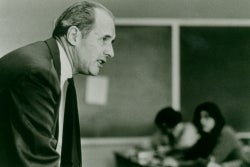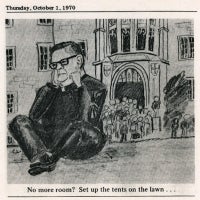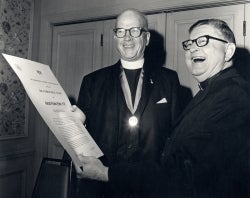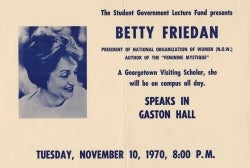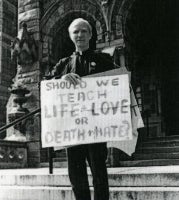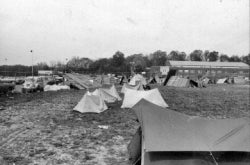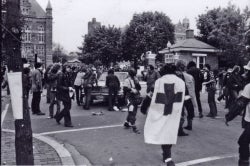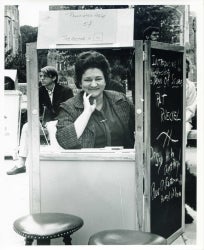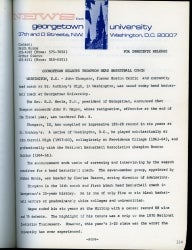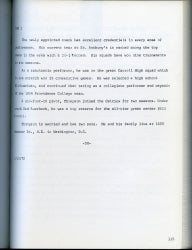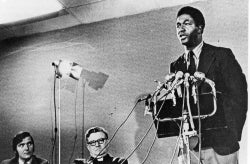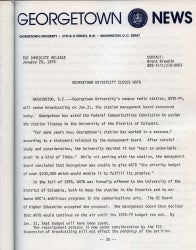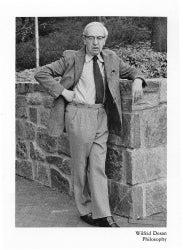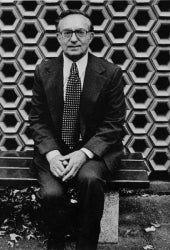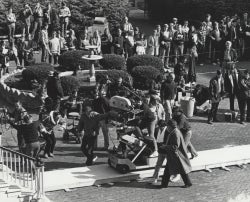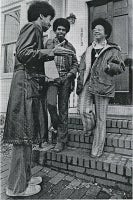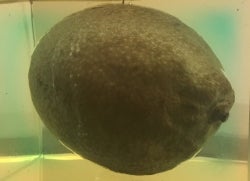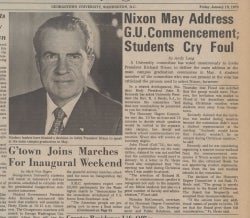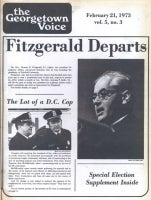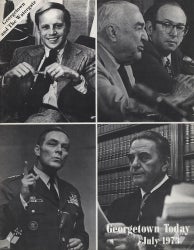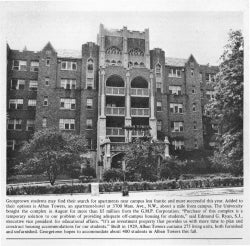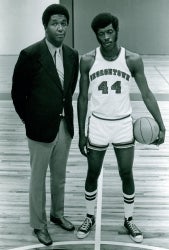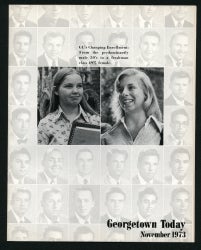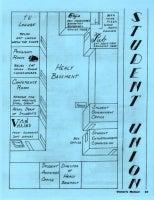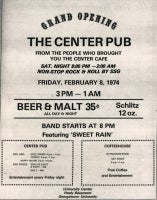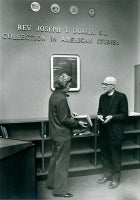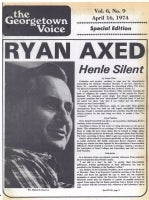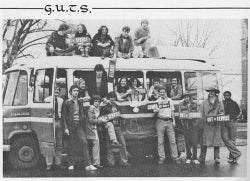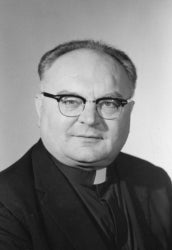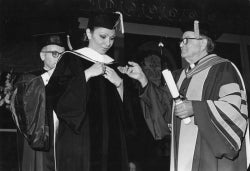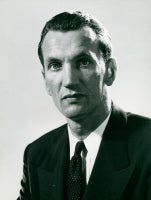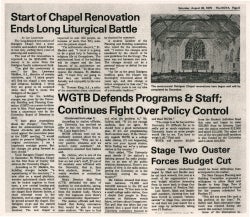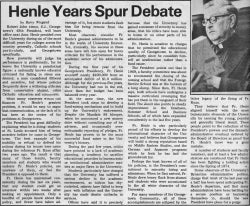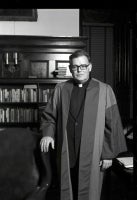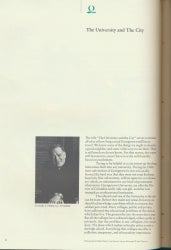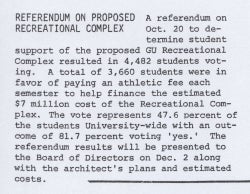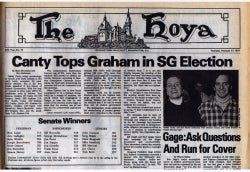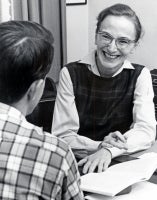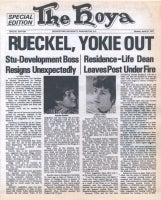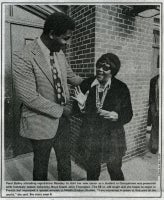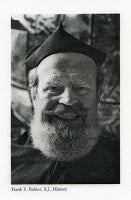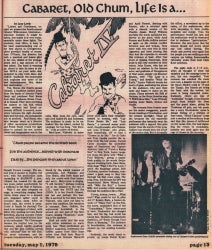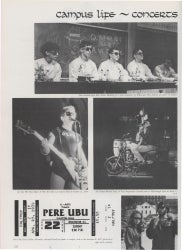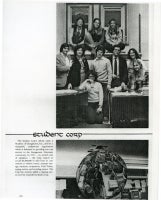Fr. Robert J. Henle, S.J. Georgetown University President, 1969-1976
Fr. Henle was inaugurated as Georgetown’s 45th President in 1969. He had previously served for ten years as academic vice president of St. Louis University. Under his leadership, the University completed a multi-million dollar construction program and the School of Medicine expanded to the second largest private medical school in the county. His most notable achievement, however, was in returning the University to a position of financial stability. When Fr. Henle became President, the University budget, in the red for the fifth consecutive year, had a projected deficit of $1.8 million. He noted in A Personal Report: Georgetown University, 1969-1976 that: To put it . . . bluntly, without money, no educational mission; without an educational mission, no University. That’s how simple the matter was. I saw no choice except to accept the obligation of financing the University as my immediate and first concern when coming to Georgetown. By the time of his resignation in 1976, he had balanced a budget that had grown to $191 million a year.
Georgetown vs. LSU in NIT first round, March 15, 1970. Ye Domesday Booke, 1970
Pete Maravich (#23) is pictured in the left side photograph with his trademark droopy socks. Pictured from the Hoya squad are: Mike Laska (#34); Mike Laughna (#42); and Art White (#44).
The Hoyas were selected to play the Pete Maravich-led LSU Tigers in the NIT. Although Maravich had scored 1304 points that season (more than any Georgetown player had scored in their career), the Hoyas refused to be intimidated by him. A banner displayed at a McDonough Gym pep rally two days before the game expressed this sentiment: Pistol Pete is a paper tiger. The combination of a special defense (the triangle tracer), a 28 point effort by Art White, and an impressive defensive performance by Mike Laska enabled Georgetown to hold Maravich to only twenty points (his average was 44.2.) But LSU eked out an agonizing 83-82 victory.
“Georgetown to name new library for alumnus killed in Vietnam.” News from Georgetown University, March 10, 1970
Lauinger Library, which opened in April 1970, was named for Joseph Mark Lauinger, a 1967 alumnus and Army first lieutenant from Tulsa, OK, who was killed while commanding a reconnaissance mission in Vietnam on January 8, 1970. Making the naming announcement, President Henle stated that the decision reflects a tradition of dedication and devotion to Georgetown, to our Church and to mankind. It provides the entire Georgetown community with an enduring impetus and a perpetual reminder of devoted service and supreme sacrifice. Lieutenant Lauinger was posthumously awarded the Silver Star for gallantry in action, the Bronze Star Medal, and the Purple Heart. These medals are on display in the lobby of the Library.
Lauinger Library staff badge
Carroll Quigley
Carroll Quigley, Professor of History at Georgetown for 35 years, retired in 1976. His Development of Civilization course was cited by School of Foreign Service alumni from 1941 to 1969 as the most influential in their undergraduate careers. His associate, Dorothy Brown, commented at the time of his death in January 1977, that he had probably taught more undergraduates than any other professor at the University. His excellence was not only demonstrated in history but also in the breath of his interest in such diverse areas as energy, evolution and ecology. The main thing is, he was a master teacher - dynamic, concerned and caring. There are few world historians. Professor Quigley was unique among them. He will be missed.
Carroll Quigley’s Credo, page one
“Classes Called Off for Week During May.” Georgetown Today, July 1970
The overwhelming majority of the faculty believed that we, right on the doorstep of the national government, just could not conduct business as usual. Somehow we had to remake things so that those who wished could engage in political activity. We also had to recognize that the troubled campus atmosphere made intensive study usually characteristic of mid-May unattainable. -- Fr. Thomas R. Fitzgerald, S.J. (Academic Vice President)
The Student Senate voted for a strike of classes from Wednesday, May 6, to Friday, May 8, 1970. The strike came two days after the deaths at Kent State University and centered around demands for the U.S. Government to cease escalation of the Vietnam War into Cambodia and Laos and to unilaterally withdraw all troops from southeast Asia. The resignation of Fr. Robert K. Judge, S.J., as Dean of Men was also called for. In response, a Main Campus faculty group voted 156-13 to suspend classes.
No classes were held from May 8-15, although students were able to meet with their teachers and to take final exams as scheduled on a voluntary basis. Alternatively, students were able to settle for existing grades or make arrangements to submit papers in place of final exams.
Letter from President Henle to Georgetown parents re cancellation of classes, May 26, 1970
Poster for Junior Prom, 1970
The Georgetown Voice reviewed B.B. King’s performance in its May, 7, 1970 issue: With performances such as the one he put on at Georgetown’s Junior Prom, it’s no wonder that people are waking up to B.B. King. He puts on a show that has such strength and feeling that any audience is bound to get its money’s worth. And the Junior Prom Committee couldn’t have picked a better man than B.B. King to give Georgetown the kind of show that everyone can dig.
“No more room? Set up tents on the lawn . . .” The Hoya, October 1, 1970
By 1972, more than 50% of undergraduates lived off campus.
Fr. Gerard F. Yates, S.J., reviews his citation for the Patrick Healy Award with President Henle (right), October 3, 1970
Fr. Yates spent forty years at Georgetown as Professor of Government, Dean of the Graduate School, director of international student programs, foreign student advisor, and as a long-time member of the Chimes singing group. The Field House at Georgetown bears his name.
When asked why he became a Jesuit, he replied: The Order seemed to stand for great things – the spread of God’s kingdom at every level. Chivalry was still a reality . . . when I was a boy, and the Society of Jesus was to me a spiritual chivalry and a disciplined army. I came to see them as men formed in a great school, modeled on a noble pattern; and I thought if I could be that kind of man that they were . . . there was nothing better I could ask or do in life.
The Patrick Healy Award is named for Fr. Patrick F. Healy, S.J., who was president of Georgetown University from 1874 to 1882. The first African-American to serve as president of a major American university, he led Georgetown through a period of extensive growth and is credited with transforming the University from a small liberal arts college into a modern University. The Award is given annually to a non-alumnus who continues Fr. Healy’s tradition of service to Georgetown.
Georgetown University Shop advertisement. The Hoya, November 5, 1970
The building occupied by the Shop, located at 36th and N Streets, was dedicated as the Mortara Building in 2005 and is now home to Georgetown’s Mortara Center for International Studies.
Coat hanger from Georgetown University Shop. Gift of Kenneth F. Hodges
Poster for lecture by Betty Friedan, November 10, 1970
Declaring that no man, woman, or child can escape the necessity of completing this revolution, Ms. Friedan spoke about the Women’s Liberation Movement in a packed Gaston Hall.
Fr. Richard T. McSorley, S.J., demonstrates for nonviolence on the steps of Healy Hall, ca. 1971
Fr. McSorley began teaching philosophy and theology at Georgetown in 1961. He was active in the peace movement, in working to end racial segregation, and in establishing Catholic Worker communities. Director of the Center for Peace Studies at Georgetown until his death, he authored several books and hundreds of columns and articles on peace and social justice. In his 1996 autobiography, My Path to Peace and Justice, he wrote: We were created to praise, love and serve God and our neighbors, and in this way to save our souls.
In a letter of condolence read at Fr. McSorley’s wake in 2002, former U.S. President and Georgetown graduate Bill Clinton recalled a 1969 trip to Europe during which he and Fr. McSorley had prayed for peace together in London and had visited a peace center in Oslo. Clinton noted that: Fr. McSorley was a man of great character who always stood by his abiding commitment to promoting and expanding his belief in the cause of peace, fearless in the face of harshest criticism, unwavering in his search for moral reason while inspiring many to do the same.
Flyer for May Day protests, 1971
Tents of May Day protestors pitched on Georgetown’s athletic field, May 2, 1971
During the weekend of May 1-2, 1971, Washington was inundated with protestors against the Vietnam War. Most of the protestors camped in West Potomac Park, adjacent to the National Mall. On Sunday, May 2, at 6:30 a.m., D.C. police cancelled the demonstrators’ camping permit and drove them out of the park. Many were told that the University had opened to protestors and, throughout the day, a steady stream of protestors arrived on campus, setting up tents on the athletic fields and – once it began to rain – filling every dorm.
The protestors were peaceful and the University concluded, in consultation with the Metropolitan police, that it would be close to impossible to clear the buildings. Student comptroller Neil Shankman supervised the army-style feeding of the protestors who departed between 5:30 and 6 a.m. the next morning.
Main gates of the University, May 3, 1971
After 8 a.m. on May 3, 1971, waves of demonstrators, who had been attempting to block traffic, were driven through Georgetown by police using tear gas. As the gas reached campus, a decision was made at 9:15 a.m. to cancel exams – 15 minutes before the exams were due to start - although it appears some exams did take place. An area for washing off pepper and tear gas was set up in the Bles Building and student marshals worked, at great personal risk, to try and keep police and demonstrators apart. Afternoon exams were cancelled at 12:20 p.m. By 4:15, the demonstrators, who were estimated by the University to have numbered about 2500, had left campus.
There were no reports of serious personal injury and, surprisingly, property damage was quite limited. American University and George Washington University experienced similar situations to Georgetown and the three universities were in continuous contact, sharing information and advice.
Patricia Rueckel, Vice President for Student Development, pictured in 1971. Photograph by Patrick M. Early, C’1974, Photo Editor of The Hoya
Dr. Rueckel, using an idea borrowed from Charles Schultz’ Peanuts comic strip, set up a booth at Healy Circle where students could consult her for a fee of 5 cents – the money going to projects such as the University Center. She explained her actions by saying: I don’t have as much student contact as I used to have . . . I see the kids who are politicals and I see the kids who are in trouble and I see the ‘goody-goodies’ but I don’t see the regular students. On her first day of operation in October 1970, she (and her French poodle Seamus) grossed 92 cents.
Dr. Rueckel came to Georgetown in the fall of 1961 to fill the newly created position of Dean of Women. She served in that capacity until 1969, when she was appointed Vice President for Student Development. With this appointment, she not only became the first woman vice president at Georgetown, she also occupied the highest position of any woman in the 28 Jesuit colleges and universities in the U.S. She resigned her position at the end of the 1976-1977 academic year.
“Georgetown Selects Thompson Head Basketball Coach.” News from Georgetown University, 3/13/1972
A seven-member screening committee chaired by Charles Deacon, then president of Hoyas Unlimited and acting director of admissions, reviewed more than 50 applications before recommending Coach Thompson, who was only the seventh African American hired as a head basketball coach at a predominantly white college.
Coach Thompson had won several championships as a player, including the 1963 NIT Championship with Providence College. As a professional player, he was a member of two world champion Boston Celtic teams. He began his coaching career at St. Anthony’s High School in northeast D.C.
John Thompson at press conference to announce his appointment as basketball coach, March 14, 1972
President Henle introduced Coach Thompson by saying: John has proven ability as a coach, manager, inspirer, and leader of young people. He is a man of high personal ideals any man would be proud to work with. It is important for Georgetown that we attain an excellent program which is consistent with our academic ideals.
In January 1999, after 26 and a half seasons, John Thompson resigned as head men’s basketball coach. He had led Georgetown teams to 20 NCAA Tournaments, seven Big East Championships, three Final Four Appearances, and one National Championship.
WGTB advertisement. An Introduction to Georgetown University, 1972
WGTB was founded as the Georgetown Broadcasting System in 1941. In 1959, it applied for an FM license and became the first educational radio station in Washington. Initially, WGTB primarily aired news and public affairs shows but, over time, shifted to more music-oriented programming. In 1972, the station began broadcasting twenty-four hours day and could reach listeners within a sixty mile radius.
During the course of the 1970s, the station’s increasingly counter-culture perspective lead to clashes with the University’s administration, rumblings from the FCC, and a series of shut-downs. A rise in the number of non-Georgetown staff at the station lead to charges that WGTB was no longer Georgetown’s radio station and no longer served the student body. A 1975 poll of students found 412 in favor of shutting the station, with 293 opposed.
“Georgetown University Closes WGTB.” Georgetown News, January 29, 1979
WGTB-FM ceased broadcasting on January 31, 1979, when its 1978-1979 budget ran out, and Georgetown asked the Federal Communications Commission to assign the station license to the University of the District of Columbia. The license was later sold by UDC to C-SPAN.
Wilfrid Desan. Ye Domesday Booke, 1978
Born in Bruges, Belgium, Wilfrid Desan (1908-2001) came to Georgetown to teach philosophy in 1957 and retired in 1978. He was an authority on Jean-Paul Sartre whom he had known in Paris in the 1940s. A popular figure on the Georgetown campus, he was nicknamed "the old pro" and, in 1977, was elected Best Professor by the student body. Also in 1977, he was awarded an honorary degree on the occasion of Timothy S. Healy’s inauguration as University President.
His honorary degree citation reads in part: Wilfrid Desan has always been more than a scholar. Indeed, he is one of Georgetown’s truly great teachers. Whether students express their delight in calling him “the old pro” in response to the carefully planned yet beautifully fluent character of his classroom teaching, or simply state their sincere thanks for the wisdom of counsel in his office, they give voice to the same conviction as his colleagues. The conviction that here is a man with a profound moral commitment, a consistent and penetrating vision into the human demands of the present world crisis, and a serene rapprochement with the long tradition of Christian Humanism.
Campus map, 1972. From Student Life Handbook, 1972-1973
Jules Davids. Ye Domesday Booke, 1978
Jules Davids taught U.S. diplomatic history at Georgetown from 1946 until his retirement in 1986. He worked on the late President John F. Kennedy’s Pulitzer Prize winning book, Profiles in Courage, and was well-known for his books on world affairs, including America and the World of Our Time: U.S. Diplomacy in the 20th Century, published in 1960. In 1979, he received an award for teaching from the School of Foreign Service and he received the Centennial Award for University service in 1982.
In his 1986 Dean’s Report, Foreign Service School Dean Peter F. Krogh said of Davids, that he [Davids]: established himself as the class-teacher scholar in the finest tradition of faculty whose continuing inspiration and reward are their students. Jules Davids was the unpretentious, caring, accessible mentor to generations of students. They properly remember him as exemplifying the very meaning of the word “mentor.”
Filming of The Exorcist, October 1972
The Exorcist film crew spent approximately twenty days in the Washington area and seven days on campus, filming at various locations, including outside and inside Healy Hall and on the steps leading from Lauinger Library to 37th Street. Many interior scenes were shot in a wing added to the house at 3600 Prospect Street. Around 300 Georgetown students were used in the production, mainly in crowd scenes. Some Jesuits and faculty members also appear.
The movie was based on the best selling novel of the same name, written by William Peter Blatty (C’50.) Mr. Blatty won an Academy Award in 1973 for the movie’s screenplay. He also produced the movie which was nominated for Best Picture but lost to The Sting.
The Exorcist shooting schedule. Open to October 24-28, 1972
Black Student House. Exterior pictured in Georgetown Today, March 1973, with BSA members Lynn Johnson, Conan Louis and Paula Scott
The first Black Student House was located at 3919 O Street. A yellow townhouse, it had a distinctive black, red and green front door. The House was created after a group of black students met with President Henle to discuss their needs on campus and to ask for more services.
Lemon encased in acrylic, 1973
This lemon was a participant in the “lemonstration” of February 2, 1973, during which students placed around 6000 lemons against the door to the President’s Office, while the Board of Directors was meeting inside. The students were protesting proposed increases in tuition and board and rising enrollments. Lemons were sold by student vendors in front of Healy Hall, who hawked their wares by shouting slogans such as: Buy a lemon. Show the Board of Directors your education has gone sour. Student body president John B. Kennedy estimated that about 50 percent of the student body took part in the protest.
Undeterred, the Board approved the increases.
“Nixon May Address G.U. Commencement. Students Cry Foul.” The Hoya, January 19, 1973
The decision to invite President Nixon to address graduates and to award him an honorary degree drew angry protests from student leaders who threatened a walk-out if the President attended. In April 1973, shortly before the resignations of presidential aides H.R. Haldeman and John Ehrlichman and the firing of John Dean (L’1965), President Nixon turned down the invitation and the University announced that the Most Rev. William Baum, Archbishop-elect of Washington, would be the principal speaker at commencement.
“Fitzgerald Departs.” Georgetown Voice, February 21, 1973
In 1973, after nine years at Georgetown, Vice President for Academic Affairs Fr. Thomas R. Fitzgerald, S.J. – known to students as “Fr. Fitz” or “the silver fox” – resigned to become president of Fairfield University in Fairfield, Connecticut.
Fr. Fitzgerald came to Georgetown as Dean of the College in 1964 and was appointed Academic Vice President in 1966. A popular administrator who took a strong interest in the affairs of student government, he resided on the third floor of New South as the corridor Jesuit and often invited groups of students to his office in the evenings to talk.
Dorothy M. Brown receives the Edward B. Bunn Award from College of Arts and Sciences Dean Royden B. Davis, S.J., May 19, 1973
Dr. Brown joined the Georgetown faculty in 1966 and was elected to chair the History Department in 1973. In 1998, she was appointed interim Provost and she served as Provost from 1999 until her retirement in 2002. Fr. James Walsh, S.J., delivered a toast to Dr. Brown in the Jesuit Community Dining Hall on May 20, 2002, on the occasion of her retirement. It included the following: She was famous as a teacher. Students have told me of Dorothy’s patented method of learning their names: by walking up and down the aisles as they took the first exam of the semester. Students say she had their names “nailed.” I prefer to say that she had them by heart, and for good. Her teaching affected and reached each student personally . . . [her] teaching – working with students on term papers, inspiring with snappy and memorable lectures – left a lasting impression on her students.
Fr. Royden B. Davis, S.J., served as Dean of the College from 1966 to 1989. In that time, he oversaw the launch of the American Studies Program and of the Departments of Psychology, Sociology and Computer Science, as well as the expansion of the Fine Arts Department. He is also remembered for helping open the College to women students in 1969. The Performing Arts Center on campus is named for him. Maryann Gallivan ( C’90), said of him when he retired: Some call him Father Roy, and some call him Father Davis, and some call him Royden. But people always smile when they say [his name] because he’s such a good person. And everyone really loves him.
The Bunn Award honors excellence in the teaching of undergraduates. It is presented annually during the College Tropaia Exercises to a member of the College faculty.
“School of Languages Names Alatis Dean.” Georgetown Today, July, 1973
James E. Alatis came to the School of Languages and Linguistics in 1966 as Associate Dean. He resigned as Dean in 1994.
Georgetown Today, July 1973
On June 17, 1972, several men were caught breaking into the Democratic National Committee office at The Watergate. At first, this was viewed as nothing more than a minor burglary. Over time, however, direct connections to President Richard Nixon's re-election campaign, and to the President himself, were uncovered and, after two years of investigative reporting, judicial proceedings, and Congressional hearings, President Nixon resigned.
Pictured on this cover are four men with connections to Georgetown whose lives were impacted by the fall-out from Watergate. They are, clockwise from top left:
--John W. Dean III (L’1965), Counsel to President Nixon, who was called in by John Erlichman and H.R. Haldeman to coordinate the Watergate cover-up. White House officials later tried to paint him as the mastermind behind the conspiracy. His testimony before the Senate Select Committee provided the core evidence linking President Nixon to the cover-up
--Samuel Dash, wearing glasses, (Professor at the Georgetown University Law Center), who served as chief counsel and staff director of the Senate Select Committee on Presidential Campaign Activities
--Judge John J. Sirica (L’1926), Chief U.S. District Judge
--General Alexander M. Haig, Jr. (G’1962), who was named interim Chief of Staff by President Nixon on May 4, 1973, after the resignation of H. R. Haldeman. Haig is credited with restoring some order to the beleaguered Nixon White House and with preparing a smooth transition to the Ford Administration when President Nixon resigned from office.
Alban Towers. Pictured on back cover of Georgetown Today, September 1973
In 1973, the University bought Alban Towers, an apartment-hotel located at 3700 Massachusetts Avenue, N.W., to ease its student housing crisis. Around 320 students moved in at the beginning of the fall semester, joining around 100 sitting tenants who chose not to leave the building when Georgetown purchased it. The University would own Alban Towers until 1996.
Merlin Wilson. Georgetown University Basketball, 1973-1974. Pictured with Coach John Thompson
Merlin Wilson (C’1976) was the first major recruit of the John Thompson-era. Coached by John Thompson at St. Anthony’s, he (along with team mate Jonathan Smith) was named as a senior to The Washington Post’s All-Metropolitan Squad. After he signed to Georgetown, Coach Thompson commented: He’s an exceptionally mobile big man. He’ll be the key person in the pivot and he makes an outlet pass on the fast break as well as anyone I’ve seen and that includes the pros.
Wilson ranks second all-time in career rebounds and first in rebound average (11.4) and is one of only three Georgetown players to average in double figures for scoring and rebounding. His statistics are even more remarkable in light of the fact he played his final two years with debilitating back trouble which made it hard for him to raise his arms.
Georgetown Today, November 1973
The College class that entered the following year (1974) was the first to have a women’s majority, with a freshman class composed of 654 women and 617 men.
Statement on Energy, November 13, 1973
We have directed that all buildings, except essential medical buildings, be heated at an average temperature of 67 degrees . . .
University energy consumption dropped by 18% during the winter of 1973-1974. Over the Christmas break, many buildings were closed or had their hours of operation shortened. The temperature in the dorms was maintained at 40 degrees, just enough to prevent pipes from freezing. Resident Jesuits continued to live in the dorms and were provided with portable heaters. When asked how the Jesuits fared under these conditions, Fr. Edmund Ryan, S.J., commented: We froze.
Plan of Student Union, Healy Basement
In January 1969, President Henle announced plans to establish a University Center. The Center opened in late 1970 and, on June, 3, 1972, was dedicated as The Peter Wilson Powers Memorial Student Center. Mr. Powers, a member of the Class of the 1962, was killed in a car accident in 1968. Members of his class established a memorial fund to provide $125,000 for the renovation of Healy for the Center. The Center was dedicated during their 10 year reunion.
Located in Healy basement, the Center housed student government offices, conference halls, a television room, a coffee house, and a 70-seat theater. In 1974, the coffee house transformed into the Pub.
Dedication of the Rev. Joseph T. Durkin, S.J., Collection in American Studies in Lauinger Library. Georgetown Today, 1974
Located in the Pierce Reading Room of the Lauinger Library, the Rev. Joseph T. Durkin, S.J., Collection in American Studies was established by former students and friends of Fr. Durkin. Pictured at the Collection’s dedication in the fall of 1974 are Professor Dorothy Brown, chair of the History Department, and Fr. Durkin.
Fr. Durkin (1903-2003) first came to Georgetown in 1938 and spent almost six decades at the University as a dedicated teacher of history. He was a prolific scholar, producing more than 25 books, including biographies of Alexis Carrel and Stephen Mallory, as well as histories of Georgetown University. Fr. Durkin “retired” in 1972, shortly after helping to launch the American Studies Program, but he continued giving tutorials, advising students, participating in student retreats, researching, and writing. In his 100th year, he was still visiting Alzheimer’s patients in local nursing homes and celebrating Mass and hearing confessions at a detention facility in Arlington, Va.
“Ryan Axed: Henle Silent.” The Georgetown Voice (Special Edition), April 16, 1974
Confusion and mystery continue to reign over the circumstances surrounding the summary dismissal Thursday of the Rev. Edmund G. Ryan, S.J., executive vice president for educational affairs . . .
Fr. Ryan had been appointed to the newly created position of Executive Vice President for Educational Affairs in 1972. He frequently worked 8 a.m. to 10 p.m. days and was known as an administrator who was very accessible to students. President Henle dismissed Fr. Ryan on April 11, 1974, in a letter citing irreconcilable differences.
Students protesting the dismissal of Fr. Edmund G. Ryan, S.J., April 1974
Fr. Ryan had widespread support among the faculty and students. There were protests on campus and petitions were circulated asking for reconsideration of the decision to dismiss him. The Executive Committee of the Board of Directors requested that the full Board review President Henle’s actions.
The Board subsequently upheld the President’s decision after an eleven hour meeting, noting that: differences of approach to university administration have created a situation in which mutual confidence between the President and the Executive Vice President, necessary to effective operation of Georgetown University, no longer exists. In two related resolutions, the Board prohibited the University President from firing any top administrators in the future without prior consent from the Board and set up a committee to examine the administrative organization of the University.
Fr. Ryan was appointed President of Seattle University in January 1975.
G.U.T.S. Ye Domesday Booke, 1979
On September 4, 1974, a new shuttle bus service, run by the Georgetown University Transportation Society, was inaugurated. All drivers were Georgetown students who had to complete rigorous training. There were three initial routes – to the Law Center, Alban Towers, and Arlington. The fare was 25 cents. A pass system and $50 “G.U.T.S Unlimited” card were later introduced.
“The New GU Student: Confrontation Is Not Their Style.” Georgetown Today, January 1975
Long hair and tattered jeans are still the order of the day, but it’s generally agreed that the mood on campuses across the country has changed. Georgetown is no exception . . . Father Lawrence Madden, S.J., director of Campus Ministries [notes], “confrontation is just not their style. These students are much more into dialogue and cooperation . . . .
Poster for Georgetown University Theatre performance of Red Peppers, 1975
Fr. Aloysius P. Kelley, S.J.
A Georgetown faculty member since 1968, Fr. Kelley became acting Academic Vice President in 1973, after the departure of Fr. Thomas R. Fitzgerald, S.J., and was named Academic Vice President in March 1974. In 1979, he left Georgetown to succeed Fr. Fitzgerald as Fairfield President, a post he held until 2004. Student body President Patrick Cleary expressed regret at Fr. Kelley’s departure: Fr. Kelley has always allowed a great deal of input and shown a willingness to hear differing opinions. He’s a phenomenal worker, indefatigable. He’s often in his office by 6 a.m. and then returns after dinner until 10 p.m.
Winning shot in ECAC Southern Division Championship, March 8, 1975
An 18 foot shot by freshman Derrick Jackson (#22) with two seconds left gave the Hoyas an improbable 62-61 win over host West Virginia in the ECAC South final. The unexpected chance to win came when West Virginia missed a foul shot with 10 seconds to go. Hoya Ed Hopkins grabbed the rebound and tossed a half-court pass to Bill Thomas who spotted Jackson open to the left of the basket. Jackson faked a West Virginia defender before making the winning shot.
The ECAC-South title entitled the Hoyas to their first NCAA bid in 32 years.
It would be the first of 20 NCAA appearances under Coach Thompson.
ECAC Southern Division Championship program, 1975
Fr. Joseph Zrinyi, S.J.
Born in Hungary, Fr. Zrinyi came to Georgetown to study English in 1958. He subsequently began doctoral studies in economics and received his Ph.D. in 1962. He taught at Georgetown until 1990 and died on campus in 1992.
Noted for his remarkable memory and his anti-Marxist humor, he taught the principals of economics with enthusiasm and knew each of his students by name. He was repeatedly voted the outstanding undergraduate teacher by the senior class.
Honorary degree citation for Empress Farah Pahlavi of Iran, May 16, 1975
The Empress was in the U.S. with her husband, the Shah, on a state visit when the degree was conferred. At the degree ceremony, which the Shah did not attend, President Henle cited the Empress' leadership role for women in Iranian society and culture. She is the first woman in the long history of the Persian Empire to be crowned Empress . . . and the first woman to be given the legal right of regency during the minority of the Crown Prince.
The ceremony drew protests from Iranian students and Amnesty International and around 400 demonstrators gathered on campus during it.
Jan Karski
Born in Poland, Professor Karski joined the anti-Nazi underground after his country was invaded in 1939. Because of his knowledge of languages, his photographic memory, and extensive training as a diplomat, he frequently served as a courier. Captured by the Gestapo in 1940 and severely tortured, he was rescued by the underground. In 1942-1943, he provided some of the first accounts of the Holocaust to the West when he reported to the Polish government-in-exile and the British and American governments about what he had seen in Poland.
Professor Karski earned a doctorate from Georgetown in 1952 and taught here for over four decades. He kept a low public profile about his past until Claude Lanzmann interviewed him for the documentary, Shoah, which was released in 1985.
He received multiple honors from Poland for his wartime role, a tree bearing his name was planted on the Avenue of the Righteous Among the Nations in Jerusalem, and he was made an honorary Israeli citizen in 1994.
Statue of Jan Karski. Photograph courtesy of Daniel Powers, G'1996, G’1999, L'2009
Lech Walesa commented at the time of Professor Karski’s death in 2000 that: I believe that great heroes like Jan Karski never really die. Karski will live on in his books, in his students, in the memory of his larger than life deeds.
A statue in his memory was unveiled on campus in 2002. The memorial is a life-size sculpture of the professor sitting on a bench playing chess, his favorite game. It is located on the lawn beside White-Gravenor. The Foreign Minister of the Republic of Poland attended the ceremony to dedicate the statue
“Start of Chapel Renovation Ends Long Liturgical Battle.” The Hoya, August 30, 1975
Renovation began on Dahlgren Chapel in the summer of 1975. The $325,000 project was undertaken to make the Chapel more conducive to contemporary liturgy. The result of more than three years of planning – and the subject of much debate on campus – the renovation work included the replacement of pews with removable seating, the raising of the floor to make the entire Chapel one level, and the removal of overhead, hanging lights. Dahlgren reopened on January 31, 1976.
“Georgetown University Administration.” Freshman Register for the Class of 1979
“Henle Years Spur Debate.” The Hoya, October 22, 1975
Robert John Henle, S.J., Georgetown’s 45th President, will leave office next June. Henle presided over the University during six of the most difficult years for colleges across the country generally, Catholic schools particularly, and Georgetown specifically . . .
Fr. Timothy S. Healy, S.J. Georgetown University President, 1976-1989
Fr. Healy came to Georgetown from the City University of New York, where he was Vice Chancellor for Academic Affairs. During his time as President, minority enrollment increased to nearly 20%, the endowment increased nearly six-fold, and the University’s physical plant grew by 67% as he oversaw the construction of a dozen buildings, including the Yates Memorial Field House and the Leavey Center. A 1986 poll among leaders of higher education named him one of the five “most effective” university presidents in the country. Throughout his tenure as President, he remained an educator and scholar and, despite his heavy administrative responsibilities, found time to teach an English class every year.
He left Georgetown to assume the position of President of the New York Public Library. Upon his death in 1992, President-elect Bill Clinton (F’1968) issued a statement which read in part: Tim was the epitome of the merging of faith and intellect, a walking demonstration that there need be no conflict between the two. He loved learning and championed intellectual freedom. He lived and loved his faith and reached out to those of all faiths. He meant an enormous amount to my alma mater. He took a very good university and made it one of the nation’s best. His emphasis on providing students with opportunities for service as well as for education provided leadership for others now focusing on national and community service.
Portion of “The University and the City” by President Timothy S. Healy, S.J., from Georgetown University’s Annual Report for 1979-1980
The subject of this annual report essay – the importance of the University being an integral, involved part of Washington – was an important one to President Healy. During his tenure, the University began co-operative programs with several D.C. high schools, the Medical Center established an affiliation with D.C. General Hospital, and the Dental School opened a Dental Clinic on North Capital Street. In 1979, the first floor of Copley Hall was reserved for students participating in the District Action Project, a project that encompassed many social outreach programs.
Speech delivered by President Timothy S. Healy, S.J., at Georgetown Prep’s graduation, May 27, 1978
A compelling speaker, as well as an elegant writer, this speech is one of many by President Healy that are preserved in the University Archives. In it, he suggests “rules” for those about to enter college, including: If you find what you expected, transfer at the end of the first year; if you find what your father expected, transfer immediately and Don’t be too busy to dream. The dream isn’t the distraction; for the next four years it is the job. We, your elders, are now limited to dreams of the spirit. You, who are young, have no such limit.
“Leisure” and “Labor.” Freshman Register, 1976
Fr. Thomas M. King, S.J., pictured on the right, joined the Theology faculty in 1968 and, for over forty years, has served as a teacher, mentor, and priest at Georgetown. In 1969, he began the tradition of giving Midnight or “Last Chance” Mass to accommodate even the busiest of students. Fr. King passed away on June 23, 2009.
“Sugar’s: Still Part of the Campus.” Georgetown Today, September 1976
In 1952, Marty and June Levin bought the store, located at 35th and O streets, from “Pop” Sugar who had opened it in 1917 as a drug store. In addition to students, the Levins counted newsman Dan Rather and actress Myrna Loy among their clients. And when Robert Kennedy was running for president, his brother Edward would use the store to make phone calls because (according to Mr. Levin) he knew our phones weren’t bugged.
Sugar’s closed its doors in May 2006.
He received a standing ovation and commented that: Georgetown has surrounded me with many wonderful memories. When I returned here yesterday . . . I knew that I had left my heart here.
Georgetown University Recreational Complex Referendum Results, Mid Week Report, October 27, 1976
McDonough Gym, which opened in 1951, housed all campus sports – recreational, intramural, and intercollegiate. In the decades after the Gym’s opening, the student body increased while the University lost recreational space to new buildings. By the 1970s, the Gym was so overcrowded that those involved in recreational and intramural activities could use it only after the intercollegiate reams had practiced. As a result, intramurals would often last until midnight or later. On October 20, 1976, a referendum was held on a new recreational complex. Students were asked if they would be willing to pay an annual assessment to help fund the complex. Over 4400 students voted and, of these, 81.7% voted “yes.”
“Canty Tops Graham in SG Election.” The Hoya, February 17, 1977
Deborah Canty (C’1978) was the first woman student government president at Georgetown. In an interview given to Georgetown Today (precursor to the Georgetown Magazine), she noted: Most people felt Georgetown wasn’t ready for a woman president or they felt I couldn’t win. But now I have won, people are ready to deal with it.
“Senator Biden Speaks” (bottom half of page.) Mid-Week Report, March 2, 1977
Senator Joseph Biden (D-Del.), the youngest member of the Senate Foreign Relations Committee, discussed Congress and Foreign Policy at an informal seminar sponsored by the Georgetown Lecture Fund in the Hall of Nations on Feb. 22.
Valerie Earle
When Valerie Earle came to Georgetown as Professor of Government in 1955, she was the first woman appointed to the faculty of the Business Division. Instrumental in founding the Faculty Senate and responsible for drafting its constitution, she was elected as the first president of that body in the fall of 1967. She retired from full‑time teaching in 1986 but continued to teach part time until her death in 2004.
In 1986, she was awarded an honorary degree by Georgetown. Her degree citation reads in part: She has been, in the fullest sense, a citizen of the academy, giving freely and steadfastly of her time and energy to the common good. She is one who came to stay, and her presence has made a lasting difference.
“Kissinger Welcomed to Georgetown.” Mid-Week Report, March 16, 1977
Effective March 1, 1977, Dr. Henry A. Kissinger, former Secretary of State, accepted a joint appointment as Visiting Professor of Diplomacy at the Foreign Service School and as Counselor to Georgetown’s Center for Strategic and International Studies (CSIS). The initial appointment was for six months. President Healy noted that: The appointment of Dr. Kissinger will bring to the students of the School of Foreign Service a distinguished Secretary of State whose grasp of both theory and practice should be most valuable to the education of embryo Secretaries and aspiring diplomats. The university feels that the appointment sits well with its traditional commitment to international policy and education. Dr. Kissinger was appointed University Professor of Diplomacy in the summer of 1977.
Peter Krogh, who appears in the three photographs accompanying the article, was appointed Dean of Foreign Service School in 1970. He took charge of the School – at the age of 33 – at a time when it was having problems of identity and mission and when interest in the study of international affairs was diminishing. In 1990, after twenty years as Dean, he was awarded the President’s medal by Georgetown President Leo J. O’Donovan, S.J. President O’Donovan noted on that occasion that: The School of Foreign Service is now one of the most preeminent schools of its kind not only in our country, but in the world. Dean Krogh stepped down from his position in 1995.
SOAK flyer, November 3, 1977
The appointment of Dr. Kissinger was not without controversy and Students Opposed to the Appointment of Kissinger [SOAK] campaigned for a review of it on procedural and moral grounds. A group with the same name had earlier appeared at Columbia University while that school was negotiating for Dr. Kissinger’s services.
The actions of SOAK led to the formation of an opposition group on campus, Students Taking Advantage of the Kissinger Experience [STAKE.]
“RUECKEL, YOKIE OUT.” The Hoya (Special Edition), April 25, 1977
. . . During her tenure as dean [for Residence Life], [Valerie] Yokie or her office was the center of repeated controversies concerning housing policies and residence hall direction. However, while dean, Yokie instituted zero-based budgeting, raised summer housing income from $87,000 to $780,000 and instituted the Resident Director program. She also eliminated female quotas for residence halls, expanded the housing lottery and eliminated the housing of men by QPIs.
Following an investigation by the Student Life Policy Committee (SLPC) into the philosophy and practices of Residence Life, Dean Yokie resigned. A story in The Hoya about the firing of five resident assistants had lead to the SLPC investigation. Patricia Rueckel, Vice President for Student Development, resigned two days before Yokie.
Pearl Bailey is presented with season tickets by Coach John Thompson at registration. The Hoya, January 20, 1978
Singer, actress, and writer Pearl Bailey was awarded an honorary degree by the University in 1977, in inspired recognition of her profound humanity, her proliferate record of public involvement, and her continuing constructive role in attempting to close gaps among peoples and nations. She returned to the University the following year and earned a B.A. in Theology in 1985, the oldest graduate in her class at age 67. Her course of studies here stretched to seven years because of career-related leaves of absence.
Alpha Phi Omega. Pictured in Ye Domesday Booke, 1978
The Alpha Phi Omega National Service Fraternity was founded in 1925 at Lafayette College in Easton, Pennsylvania. In March 1956, the Mu Alpha Chapter was chartered at Georgetown as the 265th chapter of Alpha Phi Omega. The Chapter has accepted women since 1977.
Fr. Frank L. Fadner, S.J. Pictured in Ye Domesday Book, 1978
Fr. Fadner was an expert in Russian history, a remarkable polylinguist, and accomplished artist. He taught history from 1949 to 1978 and also served as Regent of the School of Foreign Service. In 1987, James Alatis, Dean of the School of Languages and Linguistics, recollected that: New students were often intrigued by the black gowned gentleman with the long gray beard, intelligent eyes, black cassock, beretta and flowing cape. Theories as to his identify were legion. Two particularly memorable ones were that he was either the Metropolitan [Archbishop] of Moscow in exile or the Papal Confessor. Father enjoyed his mysterious image and would note that it wasn’t bad for a boy from Neenah, Wisconsin . . .
Advertisement for Booeymonger Market and Deli. A Guide to Essential Information: Georgetown University, 1978
“Nolan Retires.” Georgetown Today, July-August 1978
Coach Thomas C. “Tommy” Nolan retired at the end of his 20th season as head baseball coach. He also served as head basketball coach from 1956-1960. At the time of his retirement, he said: I have enjoyed these many years here because it has given me the opportunity to work with many outstanding young people. Athletics is a very important part of the total education one receives at Georgetown and I have been very glad to be a part of it.
Senior Newsletter, October 1978
Suggested commencement speakers are listed at the bottom.
Poster for men’s basketball game between Georgetown and the Chinese National Team, November 16, 1978
After President Nixon and Premier Chou En-lai signed the Shanghai Communique in 1972, exchanges between China and the U.S. developed in the fields of science, medicine, trade, culture, and sports. The National Committee on U.S. China Relations (NCUSR) facilitated official exchanges under the framework of the Shanghai Communique and co-sponsored a five game tour of the U.S. by the Chinese men’s and women’s basketball teams in 1978. In their fourth U.S. game, the Chinese defeated the Hoyas, 75-69.
Profile for Schools and Candidates, 1978
Note the bar charts representing application trends between 1970 and 1978.
Michael F. Foley
Dr. Foley was appointed Assistant Professor of History at Georgetown in 1967. His early research focused on the English Civil War but he also specialized in Native American history. Extremely popular with colleagues and students alike, College seniors twice voted to award him the Bunn Award for Faculty Excellence, in 1974 and 1983. Dr. Foley died unexpectedly in June 1984. Emmett Curran, then Chair of the History Department, said the following in a homily for his friend and colleague: Teaching was his vocation and few have been his equal . . . Mike wanted students to get an education that would prepare them to live, not just to make a living. No one prepared them for such living any better. He challenged, insulted, cajoled, did anything to open their minds and their hearts, to stretch their horizons to truly know civilization, the tradition in which they half-consciously lived, to confront a world they were so ignorant of, so complacent about.
“Cabaret, Old Chum, Life is a . . .” Review of Cabaret 1979 by Lucy Lewis, The Georgetown Voice, May 1, 1979
The whole cast proved once again that the people you see walking around campus are hiding a supermanlike virtuosity under their mild Clark Kent exteriors . . .
The first Cabaret, Cabaret 1976, was organized by Frank Healey and Paul Burns and took place in Darnall Lounge. The following year, Copley Formal Lounge was the venue. In 1978, the show moved to the Hall of Nations and, by 1979, its production costs were around $6000.
Concerts. Ye Domesday Booke, 1979
Concerts held on campus during the 1978-1979 academic year included: Patti Smith (McDonough Gym, October 7); Talking Heads (Gaston Hall, October 14); Devo (Gaston Hall, October 21); Muddy Waters (Gaston Hall, February 10); Elvis Costello (McDonough Gym, April 6); and The Tubes (McDonough Gym, April 27.)
“Students Serving Students.” Owner’s Manual-How to Make the University Work for You, 1979
The Students of Georgetown, Inc. (or the “Corp”), a non-profit, student-run corporation, was chartered in 1972. Originally, it was meant to serve primarily as a “paper corporation,” providing the student body with a mechanism by which they could file suit against the University, if the need arose. However, it quickly became apparent that the Corp could provide a more useful service, that of providing for the basic needs of students on campus. Within its first year, the Corp developed numerous services, including a record co-op, a food co-op (Vital Vittles), and a shuttle bus.
Commencement, May 19, 1974
Honorary degree citation for Elliot Lee Richardson, speaker at the 1974 commencement
Criticizing the Nixon administration for undercutting the electoral and political processes with dirty tricks, former Attorney General Richardson warned in his speech that the country was on the brink of becoming so cynical about government that the democratic process might be completely undermined.
Commencement, May 27, 1979
Under cloudy skies, main campus graduates were joined by honorary degree recipients Bill Russell (former Boston Celtic), Meg Greenfield and Paul Hume (Washington Post journalists), Ashraf A. Ghorbal (Egyptian Ambassador), John Bardeen (two-time winner of Nobel Prize in physics), Edmund Pellegrino (Catholic University of America President), Edmund Gullion (dean of the Fletcher School of Law and Diplomacy) and Art Buchwald (humorist) who delivered the commencement address. Grace Estalyn Hendry, a social studies teacher at Walt Whitman High School and Sister Mary deSales McNabb, a physics and math teacher at Georgetown Visitation, also received honorary degrees.
“Art’s Amusing Advice to the Class of 1979.” The Hoya, September 28, 1979
Curated by Lynn Conway, University Archivist




